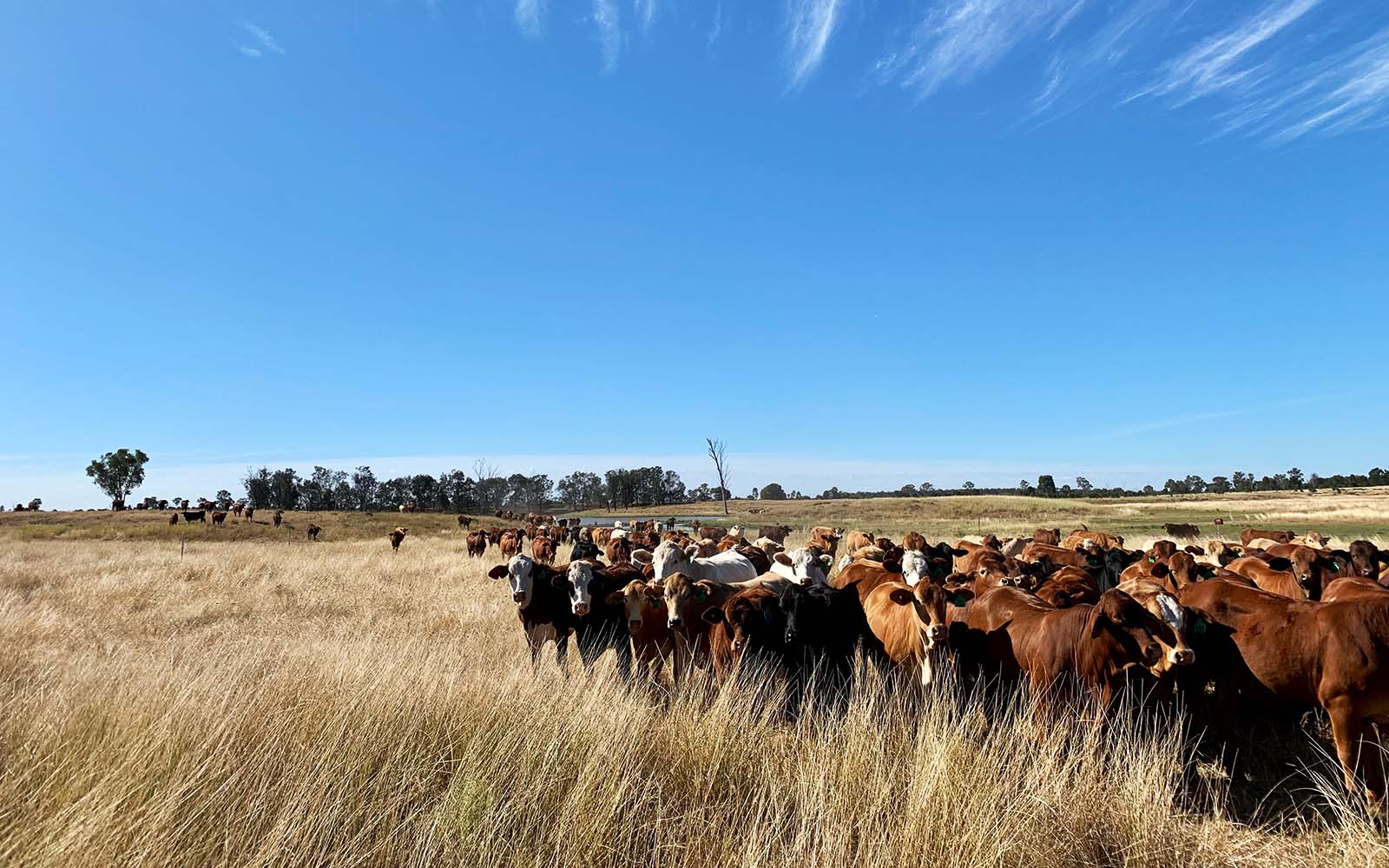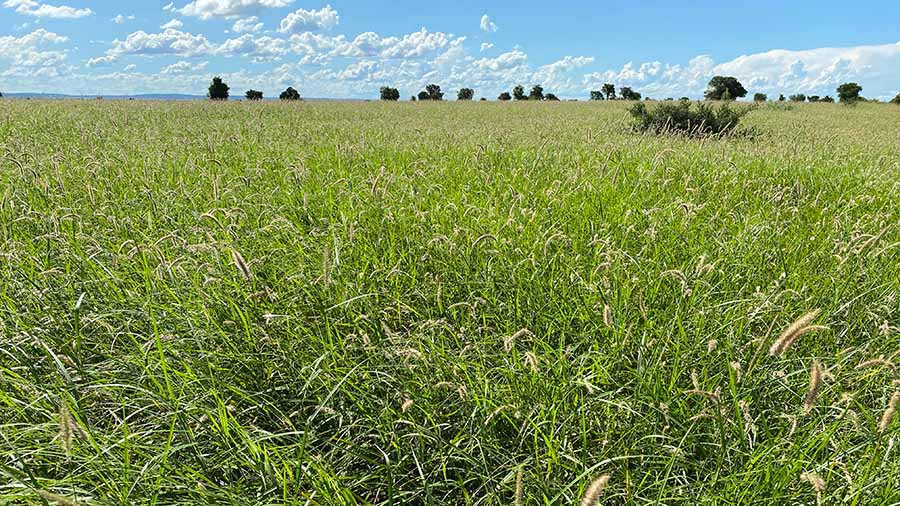Minimising risk has maximised returns for Richard and Amy Holcombe, cattle backgrounders from Moura, in central Queensland. The couple largely attribute the success of their operation - which turns over about 1,000 cattle a year - to their dedicated commitment to feed budgeting. Amy is a long-time convert to the practice. Her introduction to feed budgeting was through her father, Doug Barnard, and the lessons learned have been imprinted across her whole working career.
Handing down the budget
 A feed budget allows the Holcombes to know how much feed they have ahead of them, and hence how many cattle they can finish off their pastures.
A feed budget allows the Holcombes to know how much feed they have ahead of them, and hence how many cattle they can finish off their pastures.
For Amy, feed budgeting is key to careful management of their 1,611-hectare property, Kinma, which they bought 10 years ago. Put simply, their business converts pastures to beef. The enterprise buys in cattle weighing 220-250 kilograms. The heifers are destined for feedlots and are targeted at an entry weight of about 385 kilograms.
A feed budget allows the Holcombes to know how much feed they have ahead of them, and hence how many cattle they can finish off their pastures. Much of the feed is grown through the wet season, so around Anzac day each year, each paddock is assessed and Amy then creates a feed budget.
Assessing a paddock is not a matter of driving around and looking across paddocks but stopping and looking into them
Assessing a paddock is not a matter of driving around and looking across paddocks, but stopping and looking into them, something Amy stresses is a critical difference. Each paddock is assessed to determine the amount of Large Stock Units (LSU) it can carry until the wet season arrives. That feed budget then determines the number of heifers the Holcombes will buy and finish before the wet season rains come, which can be anytime from mid-December on.
The critical time for a feed budget is the dry season, when pastures are not actively growing. The budget allows maintenance of ground cover and protects paddocks from overgrazing. Not only does the feed budget allow a more accurate assessment of the number of cattle to purchase, but it also helps the Holcombes to forecast when cattle will reach target weights based on the feed availability and projected weight gains.
'It takes the stress away from our operation and makes us feel more confident in what we are trading,' Amy says.
'It takes the stress away from our operation and makes us feel more confident in what we are trading,' Amy says. 'We know we have "x" amount of feed until "x" date so we are not so worried about whether rain will come."
Ironically, rain can throw a spanner in the works, but the lag time between that rain and the 40-60 days until that translates into feed is where the budgeting comes into its own. In the summer of 2019-20, it was a particularly dry year, and come new year, the summer break had failed to materialise by early December. 'We knew we would have to keep making moves to sell down the majority of the herd,' Amy says.
Thanks to feed budgeting, Amy and Richard were able to make calls much earlier than most other producers in the area. This allowed them to book feedlot space for their cattle at higher prices than most producers, weeks in advance.
The process saw a mob of more than 150 cattle booked in to sell, to be trucked on 13 January 2023. On the night of January 12, it rained. 'We were asked if we were disappointed that we sold now that the rain had come,' Amy says. 'You need to ask yourself: Is it worse if it didn't rain and you kept the cattle, or if it rained and you didn't keep them?'
Taking stock
 All of the cattle at Kinma are run as one mob, a deliberate decision to maximise grazing pressure on the rostered paddock.
All of the cattle at Kinma are run as one mob, a deliberate decision to maximise grazing pressure on the rostered paddock.
All of the cattle at Kinma are run as one mob, a deliberate decision to maximise grazing pressure on the rostered paddock. It seems counterintuitive but intense pressure followed by periods of rest (longer in the dry season and shorter in the wet season) are exactly what stimulates a plant population to grow vigorously.
'As the heifers settle into routine, they get to know the process and if they see Rich come out with the dogs on the back of the bike, they will almost follow the bike to the next paddock,' Amy says.
And the beauty of the rotation through the paddocks means the cattle are constantly on the highest plane of nutrition available, maximising weight gains. The process is always managed carefully, so the pastures are grazed heavily enough but not too heavily. The careful balance ensures maximum response from the pastures.
Not an exact science
 Pasture cuts can be taken using a quadrant and then assigned a moisture level rating to the weight of the volume cut to work out an estimate of the dry matter content of the feed available.
Pasture cuts can be taken using a quadrant and then assigned a moisture level rating to the weight of the volume cut to work out an estimate of the dry matter content of the feed available.
As a long-time user of feed budgeting, Amy visually assesses her pastures and sets up a simple spreadsheet which has all the paddocks, how much feed each paddock has and the planned rotation. It's her years of experience that allow her to do this.
But there is another way. Pasture cuts can be taken using a quadrant and then assigned a moisture level rating to the weight of the volume cut to work out an estimate of the dry matter content of the feed available. This can then be extrapolated to give an assessment of the dry matter given the paddock's size.
The budget may be drawn up by the end of April but there are monthly tweaks, as some paddocks may have more stock days than anticipated.
But feed budgeting is not an exact science, and this is a point Amy is keen to stress. The budget may be drawn up by the end of April but there are monthly tweaks, as some paddocks may have more stock days than anticipated.
'I think that's the thing you need to accept, that it is not perfect and it's just an estimate,' Amy says. 'But what it does do is get people looking at their pastures, not across their pastures.'
Feeding off the benefits
By knowing the capacity of their property's grass resources, the Holcombe's business has been strengthened. They can comfortably buy in the right number of cattle knowing they will not be left short of feed, and weight gains are maximised through the rotation of stock through paddocks that are grazed and then rested.
Yet one of the biggest bonuses has been the ability to forecast turnoff dates for selling their cattle based on the feed budgets and, in turn, write cash flows more accurately. So while the rain might not always come when it should, the Holcombes take comfort in a feed budget that sets them up for success.



